Evaluation of Groundwater Quality and Health Risk Assessment During the Dry Season in the Xin’an River Basin, China
Abstract
1. Introduction
2. Materials and Methods
2.1. Study Area
2.2. Sample Collection
2.3. Methods of Assessment
2.3.1. Groundwater Quality Assessment
2.3.2. APCS-MLR Model
2.3.3. Human Health Risk Assessment Based on Monte Carlo Simulation Analysis
2.4. Statistical Analysis
3. Results and Analysis
3.1. Hydrochemical Characteristics
3.1.1. Descriptive Statistical Analysis
3.1.2. Gibbs Diagram
3.1.3. Ion Ratio Analysis
3.2. Analysis of Groundwater Quality and Influencing Factors
3.2.1. Groundwater Quality
3.2.2. Influencing Factors
Correlation Analysis
Principal Component Analysis
APCS-MLR Model
3.3. Human Health Risk Assessment Based on Monte Carlo Simulation Analysis
3.3.1. Daily Intake
3.3.2. Non-Carcinogenic Health Risk
3.3.3. Carcinogenic Health Risk
4. Conclusions
Author Contributions
Funding
Data Availability Statement
Conflicts of Interest
References
- Zhang, Y.; He, Z.; Tian, H.; Huang, X.; Zhang, Z.; Liu, Y.; Xiao, Y.; Li, R. Hydrochemistry appraisal, quality assessment and health risk evaluation of shallow groundwater in the Mianyang area of Sichuan Basin, southwestern China. Environ. Earth Sci. 2021, 80, 576. [Google Scholar] [CrossRef]
- Li, Z.; Lu, C.; Zhang, Y.; Yu, X.; Gao, Q.; Yuan, Z.; Wu, C.; Liu, B.; Shu, L. Seasonal groundwater variations in the coastal plain under intense human activities: Hydrochemical evolution, quality degradation, and health risk assessment. J. Environ. Manag. 2025, 388, 126062. [Google Scholar] [CrossRef]
- Ren, Y.; Cao, W.; Zhao, L.; Wang, S.; Pan, D.; Zhang, L.; Li, X.; Xiao, S.; Li, Z. Environmental Factors Influencing Groundwater Quality and Health Risks in Northern Henan Plain, China. Expo. Health 2025, 17, 507–522. [Google Scholar] [CrossRef]
- Sidhu, J.S.; Chandel, S.; Sahoo, S.; Singh, D.; Singh, K.; Arora, M.; Kaur, H. Hydrogeochemical characterization and geospatial assessment of groundwater quality in the alluvial aquifer of southwestern Punjab in association with health risk assessment due to nitrate and fluoride pollution. Environ. Sci. Pollut. Res. 2025, 32, 11893–11920. [Google Scholar] [CrossRef]
- Deng, J.; Yang, G.; Yan, X.; Du, J.; Tang, Q.; Yu, C.; Pu, S. Quality evaluation and health risk assessment of karst groundwater in Southwest China. Sci. Total Environ. 2024, 946, 174371. [Google Scholar] [CrossRef]
- Preethi, B.; Subramani, T.; Saravanan, R.; Gopinathan, P.; Huang, Z.; Kumar, B. Health risks due to geogenic and anthropogenic influences on groundwater quality in Southern India’s hard rock terrain. J. Geochem. Explor. 2025, 274, 107762. [Google Scholar] [CrossRef]
- Zhang, C.; Li, X.; Hou, X.; Wang, Z.; Ma, J.; Gao, M.; Fu, C.; Bai, Z.; Gui, C.; Zuo, X. Characterization of drinking groundwater quality and assessment of human health risk in Xin’an spring basin, a typical mining and karst area of the northern China. Environ. Earth Sci. 2023, 82, 282. [Google Scholar] [CrossRef]
- Edzoa, R.C.; Mbog, M.B.; Tedontsah, V.P.L.; Mamdem, L.B.; Ngon, G.F.N.; Tassongwa, B.; Bitom, D.; Etame, J.; Nguedia, K.D. Influence of leachates produced by urban waste dumps on the water quality and possible risks to public health. Water Pract. Technol. 2024, 19, 82–98. [Google Scholar] [CrossRef]
- Panneerselvam, B.; Ravichandran, N.; Kaliyappan, S.P.; Karuppannan, S.; Bidorn, B. Quality and Health Risk Assessment of Groundwater for Drinking and Irrigation Purpose in Semi-Arid Region of India Using Entropy Water Quality and Statistical Techniques. Water 2023, 15, 601. [Google Scholar] [CrossRef]
- Wei, S.; Zhang, Y.; Cai, Z.; Bi, D.; Wei, H.; Zheng, X.; Man, X. Evaluation of groundwater quality and health risk assessment in Dawen River Basin, North China. Environ. Res. 2025, 264, 120292. [Google Scholar] [CrossRef]
- Zhang, T.; Wang, M.; He, J.; Liu, J.; Gong, L.; Xia, S. Hydrochemical characteristics, evolution and health risk assessment of surface water and groundwater in Lhasa, China. Environ. Earth Sci. 2024, 83, 166. [Google Scholar] [CrossRef]
- Lechhab, W.; Lechhab, T.; Tligui, Y.; Lanjri, A.F.; Allah, R.F.; Cacciola, F.; Salmoun, F. Assessing hydrogeochemical characteristics, pollution sources, water quality, and health risks in Northwest Moroccan springs using statistical analysis. Sustain. Water Resour. Manag. 2024, 10, 169. [Google Scholar] [CrossRef]
- An, H.; Wang, T.; Meng, X.; Niu, X.; Song, D.; Wang, Y.; Gao, G.; Li, M.; Zhang, T.; Song, H.; et al. Hydrochemical Characteristics and Controlling Factors of Hengshui Lake Wetland During the Dry Season, North China. Water 2025, 17, 1468. [Google Scholar] [CrossRef]
- Lv, Y.; Li, X.; Yuan, J.; Tian, H.; Wei, T.; Wang, M.; Dai, Y.; Feng, J.; Zhang, Y.; Yang, P. Hydrogeochemical Signatures and Spatiotemporal Variation of Groundwater Quality in the Upper and Lower Reaches of Rizhao Reservoir. Water 2025, 17, 1659. [Google Scholar] [CrossRef]
- Zohud, A.; Alam, L.; Goh, C.T. Evaluation of Groundwater Quality Using the Water Quality Index (WQI) and Human Health Risk (HHR) Assessment in West Bank, Palestine. Hydrology 2023, 10, 198. [Google Scholar] [CrossRef]
- Lan, T.; Wang, F.; Bao, S.; Miao, J.; Bai, Y.; Jia, S.; Cao, Y. The human health risk assessment and countermeasures study of groundwater quality. Environ. Geochem. Health 2023, 45, 3215–3228. [Google Scholar] [CrossRef]
- Raheja, H.; Goel, A.; Pal, M. Assessment of groundwater quality and human health risk from nitrate contamination using a multivariate statistical analysis. J. Water Health 2024, 22, 350–366. [Google Scholar] [CrossRef]
- Mutileni, N.; Mudau, M.; Edokpayi, J.N. Water quality, geochemistry and human health risk of groundwater in the Vyeboom region, Limpopo province, South Africa. Sci. Rep. 2023, 1, 19071. [Google Scholar] [CrossRef]
- Zhu, T.; Wu, Q.; Gao, S.; Zeng, J.; Linghu, K.; Zhang, X. Comparative assessment of health risks and water quality of groundwater in urban and rural Guiyang, Southwest China: Insights from PMF and Monte Carlo Simulation. Ecotoxicol. Environ. Saf. 2025, 299, 118359. [Google Scholar] [CrossRef] [PubMed]
- Jadoon, W.A.; Zaheer, M.; Tariq, A.; Sajjad, R.U.; Varol, M. Assessment of hydrochemical characteristics, health risks and quality of groundwater for drinking and irrigation purposes in a mountainous region of Pakistan. Environ. Sci. Pollut. Res. 2024, 31, 43967–43986. [Google Scholar] [CrossRef]
- Yan, Y.; Zhang, Y.; Yao, R.; Wei, C.; Luo, M.; Yang, C.; Chen, S.; Huang, X. Groundwater suitability assessment for irrigation and drinking purposes by integrating spatial analysis, machine learning, water quality index, and health risk model. Environ. Sci. Pollut. Res. 2024, 31, 39155–39176. [Google Scholar] [CrossRef]
- Li, Q.; Kang, X.; Lin, G.; Yang, G.; Wu, P.; Zuo, W.; Xie, T.; Liu, Y. Groundwater quality characteristics and health risk assessment in the valley plain area of the western Qinghai-Tibet plateau. J. Contam. Hydrol. 2023, 257, 104221. [Google Scholar] [CrossRef]
- Zahra, A.; Ali, M.; Ali, N.; Khan, A.; Zairov, R.; Sinyashin, O.; Wang, Y.; Zafar, S.; Khan, F.-A. A comprehensive analysis of the impact of arsenic, fluoride, and nitrate-nitrite dynamics on groundwater quality and its health implications. J. Hazard. Mater. 2025, 487, 137093. [Google Scholar] [CrossRef]
- Wang, Y.; Liu, J.; Yu, X.; Yan, Y.; Chen, Q.; Chen, S. Evaluation of groundwater quality and health risk assessment in southeastern Tibet, China. Environ. Earth Sci. 2023, 82, 455. [Google Scholar] [CrossRef]
- Pratap, D.V.; Singh, C.S.; Aftab, A.; Kumar, S.A. Hydrogeochemical quality investigation of groundwater resource using multivariate statistical methods, water quality indices (WQIs), and health risk assessment in Korba Coalfield Region, India. Stoch. Environ. Res. Risk Assess. 2025, 39, 937–958. [Google Scholar] [CrossRef]
- Yohannes, B.A.; Olli, V.; John, G.; Tafa, O.B.; Akintayo, A.M.; Peizhe, S.; Yongkui, Y.; Lin, Z. A framework for assessing freshwater vulnerability along China’s Belt and Road Initiative: An exposure, sensitivity and adaptive capacity approach. Environ. Sci. Policy 2022, 132, 247–261. [Google Scholar] [CrossRef]
- Ma, K.; Ren, H.; Zhou, T.; Wu, F.; Zhang, G. Water quality analysis and health risk assessment of the Lanzhou section of the Yellow River. Water Supply 2022, 22, 2024–2033. [Google Scholar] [CrossRef]
- Marrugo-Negrete, J.; Paternina-Uribe, R.; Enamorado-Montes, G.; Herrera-Arango, J.; Rosso-Pinto, M.; Ospino-Contreras, J.; Pinedo-Hernández, J. Groundwater quality assessment in the La Mojana region of northern Colombia: Implications for consumption, irrigation, and human health risks. Appl. Water Sci. 2024, 14, 1–15. [Google Scholar] [CrossRef]
- Kumari, A.; Sinha, A.; Singh, D.B.; Pasupuleti, S. Source apportionment and health risk assessment in chromite mining area: Insights from entropy water quality indexing and Monte Carlo simulation. Process Saf. Environ. Prot. 2024, 184, 526–541. [Google Scholar] [CrossRef]
- Zheng, Y.; Wei, D.; Gan, J.; Zou, L.; Zhu, R.; Zhang, Y. Hydrochemical insights, water quality, and human health risk assessment of groundwater in a coastal area of southeastern China. Environ. Monit. Assess. 2024, 196, 959. [Google Scholar] [CrossRef]
- Edjah, A.K.-M.; Banoeng-Yakubo, B.; Ewusi, A.; Sakyi-Yeboah, E.; Saka, D.; Turetta, C.; Cozzi, G.; Atta-Peters, D.; Chegbeleh, L.P. Assessment of groundwater quantity, quality, and associated health risk of the Tano river basin, Ghana. Acta Geochim. 2024, 43, 325–353. [Google Scholar] [CrossRef]
- Wang, Z.; Wang, Y.; Shi, M.; Ji, W.; Li, R.; Wang, X. Coordinated analysis of groundwater spatiotemporal chemical characteristics, water quality, and potential human health risks with sustainable development in semi-arid regions. Environ. Geochem. Health 2024, 46, 370. [Google Scholar] [CrossRef]
- Maleky, S.; Faraji, M.; Hashemi, M.; Esfandyari, A. Investigation of groundwater quality indices and health risk assessment of water resources of Jiroft city, Iran, by machine learning algorithms. Appl. Water Sci. 2025, 15, 3. [Google Scholar] [CrossRef]
- Kumar, A.; Singh, A. Entropy-based groundwater quality evaluation with multivariate analysis and Sobol sensitivity for non-carcinogenic health risks in mid-Gangetic plains, India. Environ. Geochem. Health 2025, 47, 186. [Google Scholar] [CrossRef]
- GB/T 14848-2017; Ministry of Land and Resources and Ministry of Water Resources of the People’s Republic of China. Standard for Groundwater Quality. Standards Press of China: Beijing, China, 2017.
- Li, S.; Su, H.; Han, F.; Li, Z. Source Identification of Trace Elements in Groundwater Combining APCS-MLR with Geographical Detector. J. Hydrol. 2023, 623, 129771. [Google Scholar] [CrossRef]
- Ruan, D.; Bian, J.; Wang, Y.; Wu, J.; Gu, Z. Identification of groundwater pollution sources and health risk assessment in the Songnen Plain based on PCA-APCS-MLR and trapezoidal fuzzy number-Monte Carlo stochastic simulation model. J. Hydrol. 2024, 632, 130897. [Google Scholar] [CrossRef]
- Bouselsal, B.; Satouh, A.; Egbueri, J.C. Evaluating water quality, mineralization mechanisms, and potential health risks of nitrate contamination in the Continental Intercalaire aquifer of Reggane, Algeria. Environ. Earth Sci. 2024, 83, 539. [Google Scholar] [CrossRef]
- Hou, Q.; Pan, Y.; Zeng, M.; Wang, S.; Shi, H.; Huang, C.; Peng, H. Assessment of groundwater hydrochemistry, water quality, and health risk in Hainan Island, China. Sci. Rep. 2023, 13, 12104. [Google Scholar] [CrossRef]
- Dasari, B.M.; Aradhi, K.K.; Banothu, D.; Kurakalva, R.M. Assessment of groundwater quality, source identification, and health risk around oil and gas drilling sites. Environ. Earth Sci. 2024, 83, 312. [Google Scholar] [CrossRef]
- Wang, S.; Chen, J.; Zhang, S.; Bai, Y.; Zhang, X.; Jiang, W.; Yang, S. Shallow groundwater quality and health risk assessment of fluoride and arsenic in Northwestern Jiangsu Province, China. Appl. Water Sci. 2024, 14, 119. [Google Scholar] [CrossRef]
- Maurya, S.; More, A.B.; Gupta, G.; Saxena, A.; Singh, A. Hydrochemical Evaluation of Groundwater Quality and Human Health Risk Assessment of Fluoride and Nitrate: A Case Study of Pratapgarh District UP, India. Water Air Soil Pollut. 2025, 236, 204. [Google Scholar] [CrossRef]
- Yang, L.; Wu, Q.; Gao, S.; Peng, M.; Zhu, J.; Zeng, J.; Shi, L.; Li, X. Assessment of trace elements contamination and human health risk based on Monte Carlo simulation in a karst groundwater system affected by industrial activities. Ecotoxicol. Environ. Saf. 2024, 290, 117550. [Google Scholar] [CrossRef] [PubMed]
- Vesković, J.; Miletić, A.; Lučić, M.; Onjia, A. Appraisal of contamination, hydrogeochemistry, and Monte Carlo simulation of health risks of groundwater in a lithium-rich ore area. Environ. Geochem. Health 2024, 46, 468. [Google Scholar] [CrossRef]
- Lei, M.; Zhou, J.; Zhou, Y.; Sun, Y.; Ji, Y.; Zeng, Y. Spatial distribution, source apportionment and health risk assessment of inorganic pollutants of surface water and groundwater in the southern margin of Junggar Basin, Xinjiang, China. J. Environ. Manag. 2022, 319, 115757. [Google Scholar] [CrossRef]
- Elbarghmi, R.; Ghalit, M.; Abourrich, M.; El khalki, S.; Jodeh, S.; Azzaoui, K.; Lamhamdi, A. Assessment of groundwater quality and health risks in Ketama region (intrarif), Morocco. Environ. Syst. Res. 2024, 13, 30. [Google Scholar] [CrossRef]
- Rahman, S.M.; Masum, H.; Ishtiaque, A.; Sarwar, S.; Hussam, A. Water quality index and health risk assessment for heavy metals in groundwater of Kashiani and Kotalipara upazila, Gopalganj, Bangladesh. Appl. Water Sci. 2024, 14, 106. [Google Scholar] [CrossRef]
- Zhao, L.; Wang, Z.; Kong, L.; Zhao, Z.; Geng, B.; Gu, S.; Li, Y.; Han, X.; Liu, S.; Li, B.; et al. Risk assessment of soil heavy metals in mining activity areas: A case study in Eastern Shandong Province, China. Environ. Earth Sci. 2023, 82, 513. [Google Scholar] [CrossRef]
- Fan, B.L.; Zhao, Z.Q.; Tao, F.X.; Liu, B.J.; Tao, Z.H.; Gao, S.; Zhang, L.H. Characteristics of carbonate, evaporite and silicate weathering in Huanghe River basin: A comparison among the upstream, midstream and downstream. J. Asian Earth Sci. 2014, 96, 17–26. [Google Scholar] [CrossRef]
- Edet, A.; Ukpong, A.; Ekwere, A.; Wiche, O.; Nganje, T.; Adamu, C.; Kudamnya, E. Assessment of surface water and groundwater quality and their associated human health risks around dumpsites, Cross River State, Southern Nigeria. Environ. Earth Sci. 2025, 84, 234. [Google Scholar] [CrossRef]
- Gibbs, R.J. Mechanisms controlling world water chemistry. Science 1970, 170, 1088–1090. [Google Scholar] [CrossRef]
- Kong, L.; Chu, H.; Hou, G.; Zeng, J.; Zhao, L.; Han, X.; Li, Y.; Zhou, F.; Yin, M.; Zhang, X. Characteristics and mechanisms of sea (salt) water intrusion in Laizhou City, Shandong Province, China. Front. Mar. Sci. 2025, 12, 1578175. [Google Scholar] [CrossRef]
- Zheng, Z.; Li, P.; Elumalai, V.; Zhou, T. Impacts of Land Use/Land Cover Changes on Groundwater Fluoride and Arsenic Levels: A Case Study in the Central Yinchuan Plain, China. Expo. Health 2025, 17, 1095–1110. [Google Scholar] [CrossRef]
- Alarcón-Herrera, M.T.; Martin-Alarcon, D.A.; Gutiérrez, M.; Reynoso-Cuevas, L.; Martín-Domínguez, A.; Olmos-Márquez, M.A.; Bundschuh, J. Co-occurrence, possible origin, and health-risk assessment of arsenic and fluoride in drinking water sources in Mexico: Geographical data visualization. Sci. Total Environ. 2020, 698, 134168. [Google Scholar] [CrossRef] [PubMed]
- Wang, Y.; Li, J.; Xie, X. Genesis and occurrence of high iodine groundwater. Earth Sci. Front. 2022, 29, 1–10. [Google Scholar] [CrossRef]
- Li, J.; Zhao, S.; Jiang, Z.; Xie, X.; Deng, Y.; Shi, L.; Kappler, A.; Van Cappellen, P.; Wang, Y. Spatial distribution and formation mechanisms of high-iodine groundwater throughout China. Earth-Sci. Rev. 2025, 265, 105134. [Google Scholar] [CrossRef]


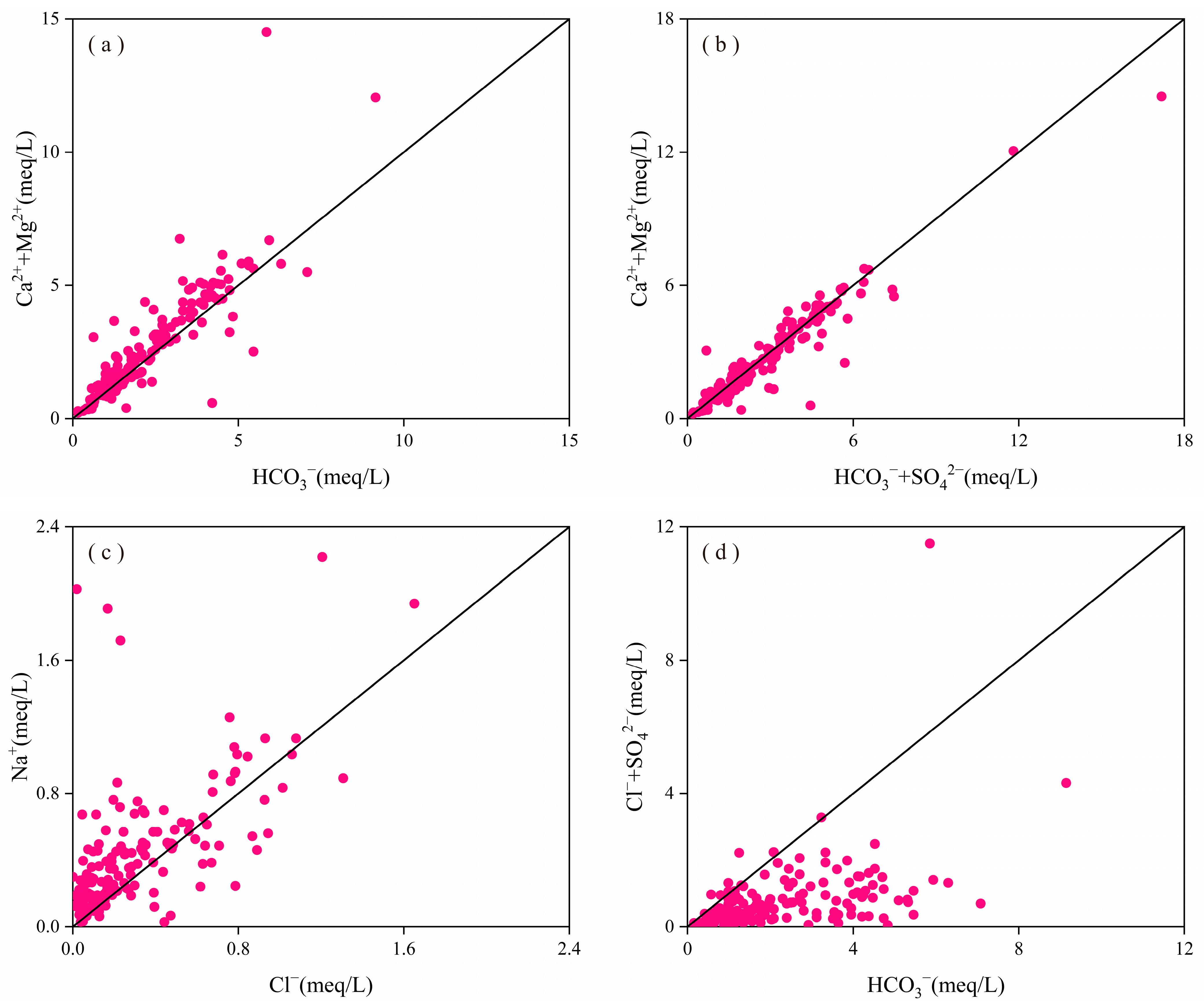

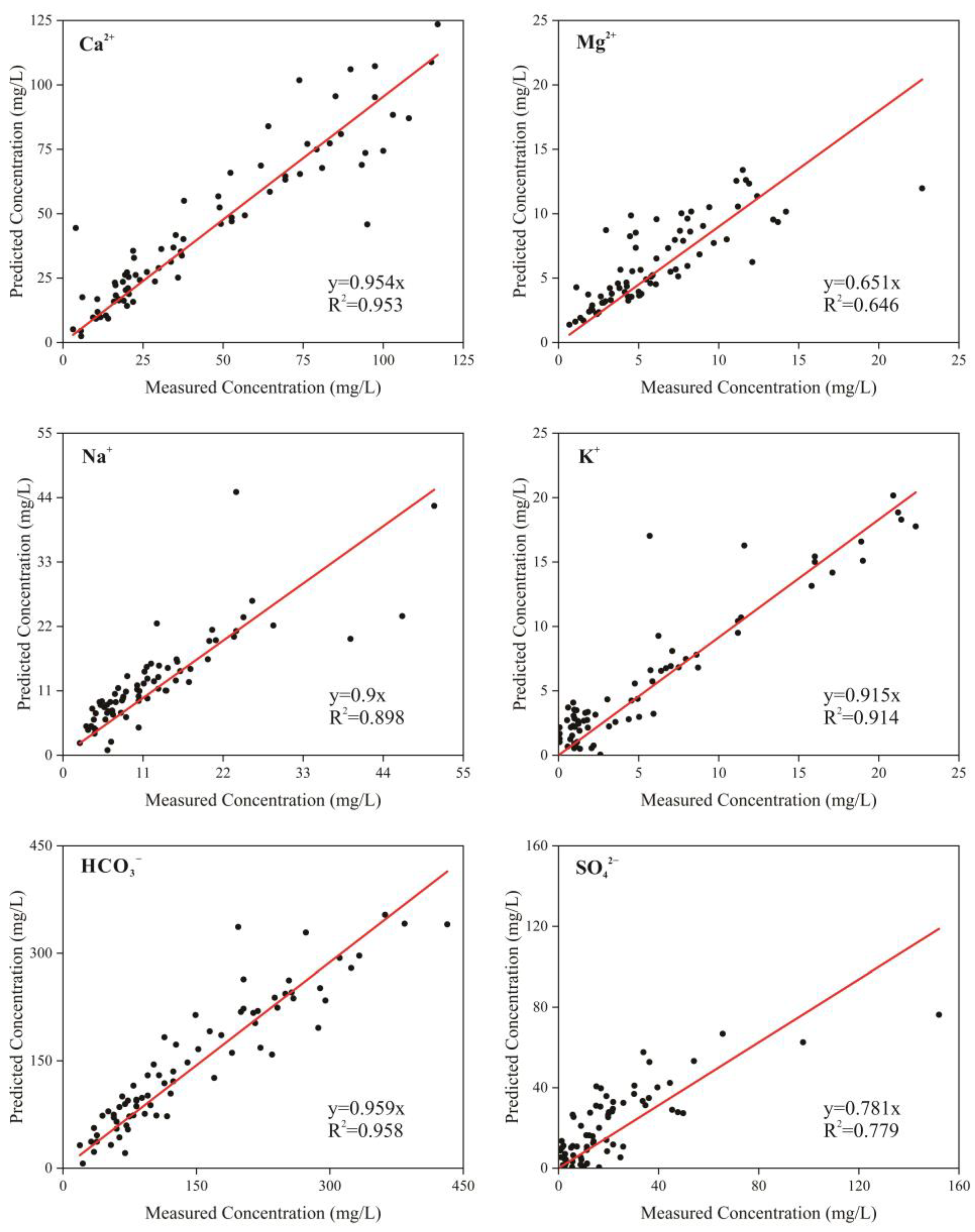
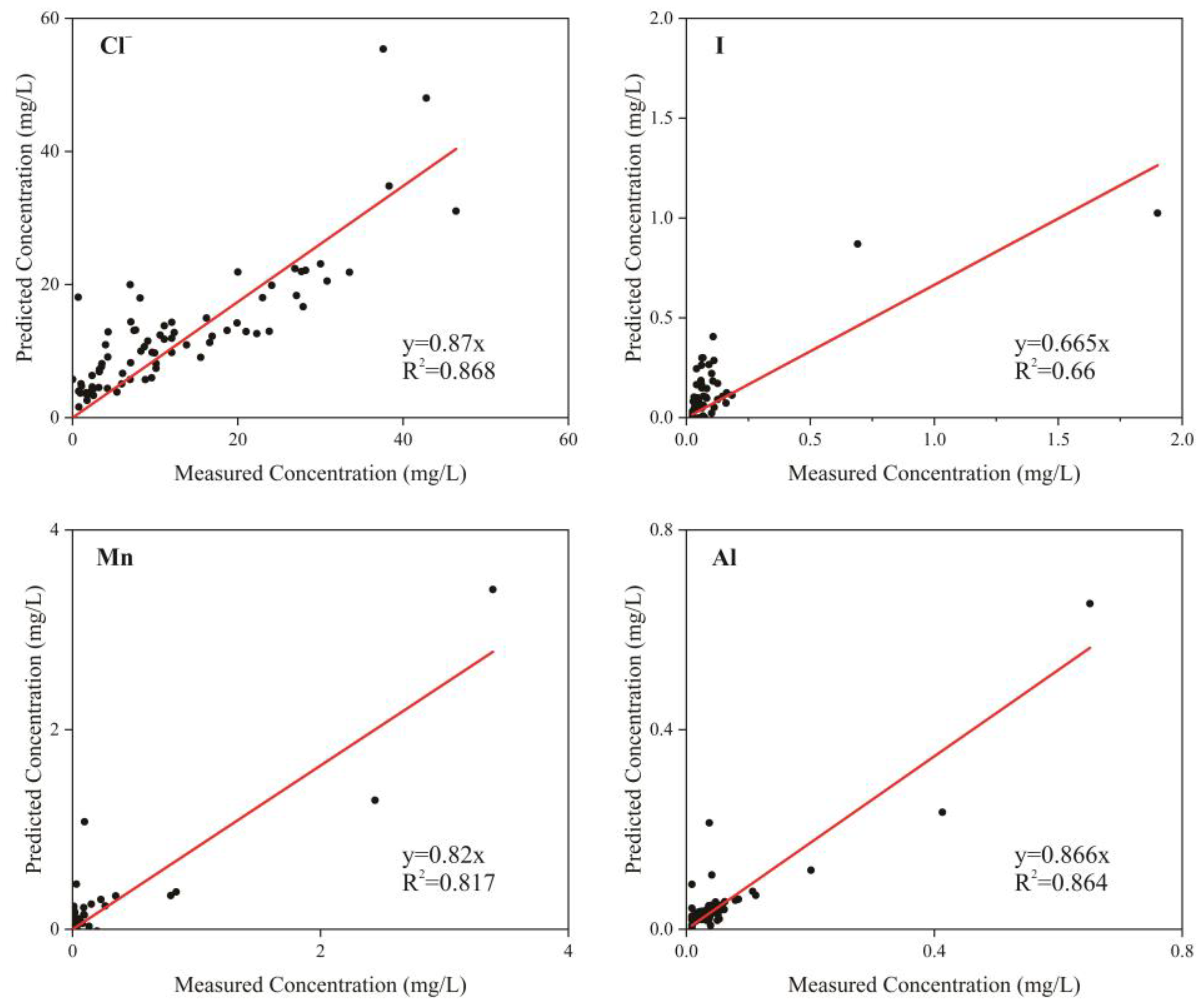

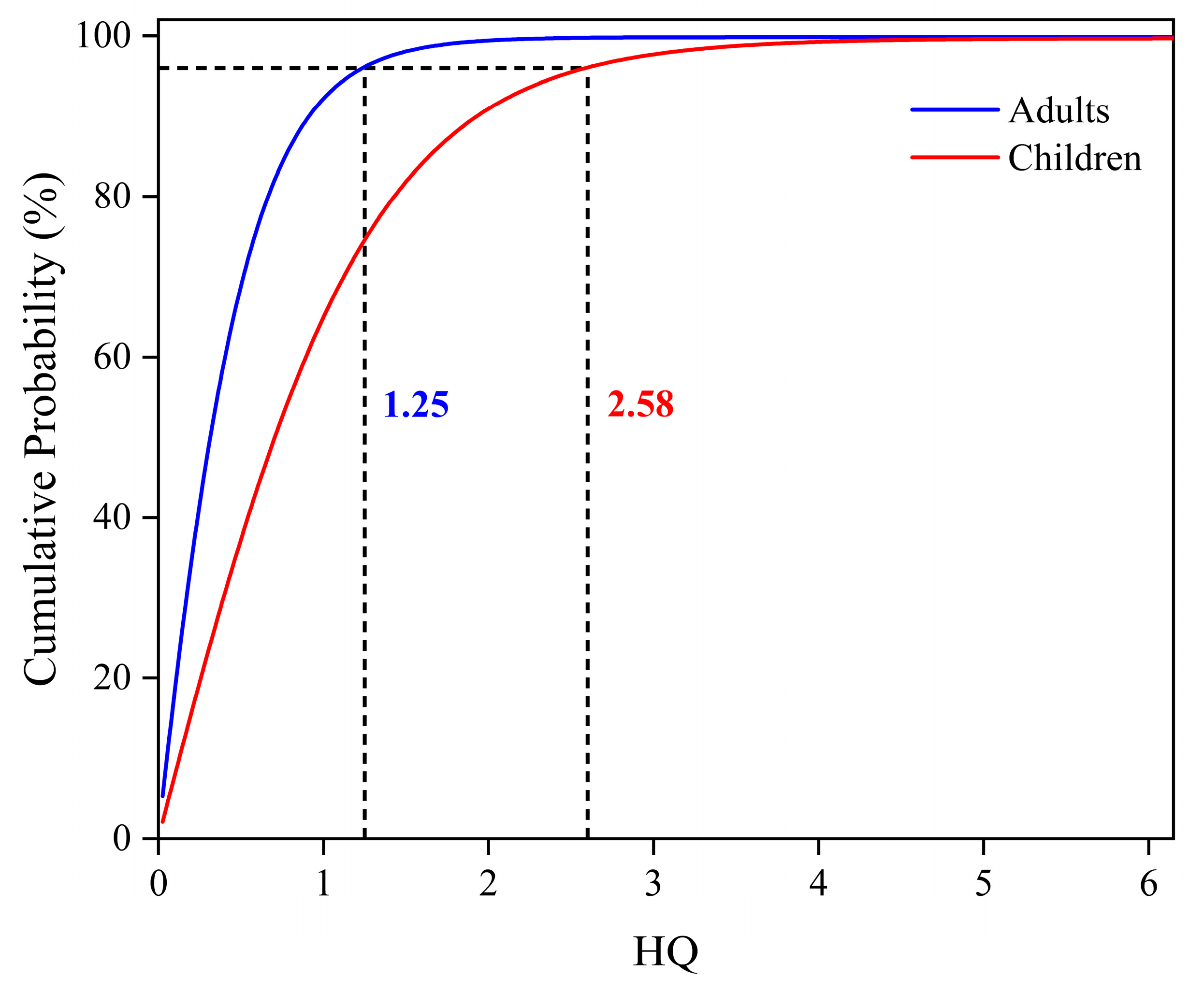
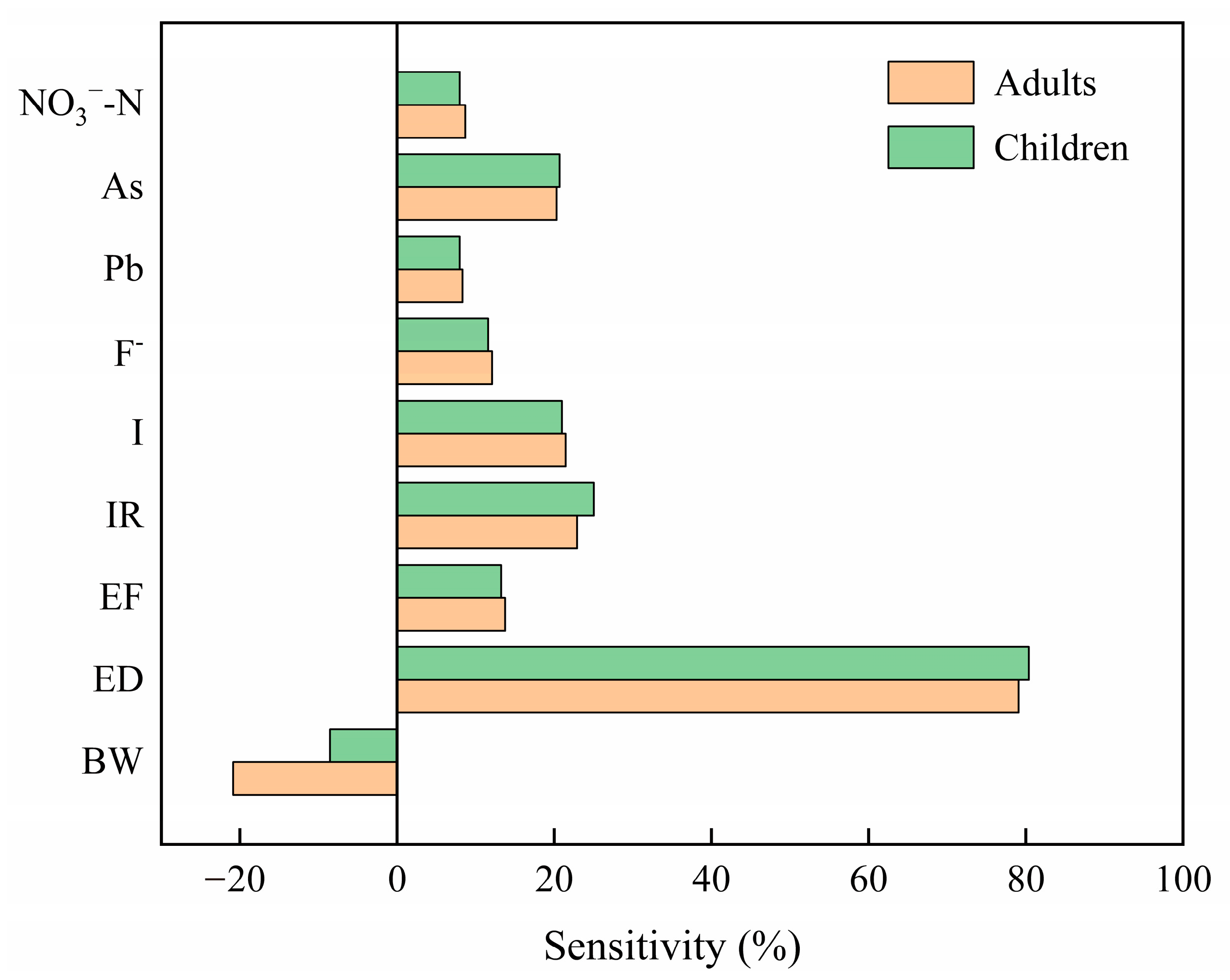
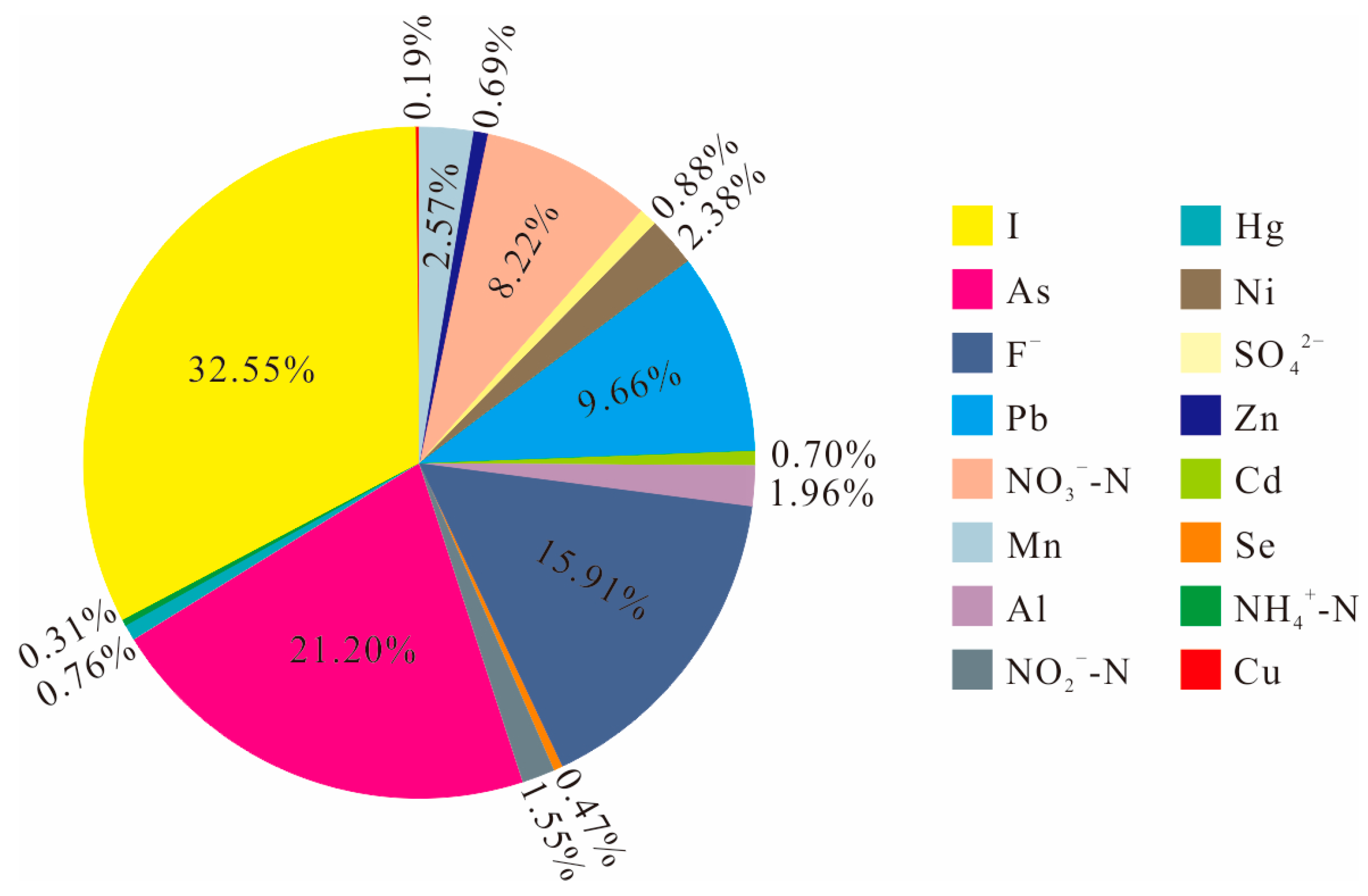

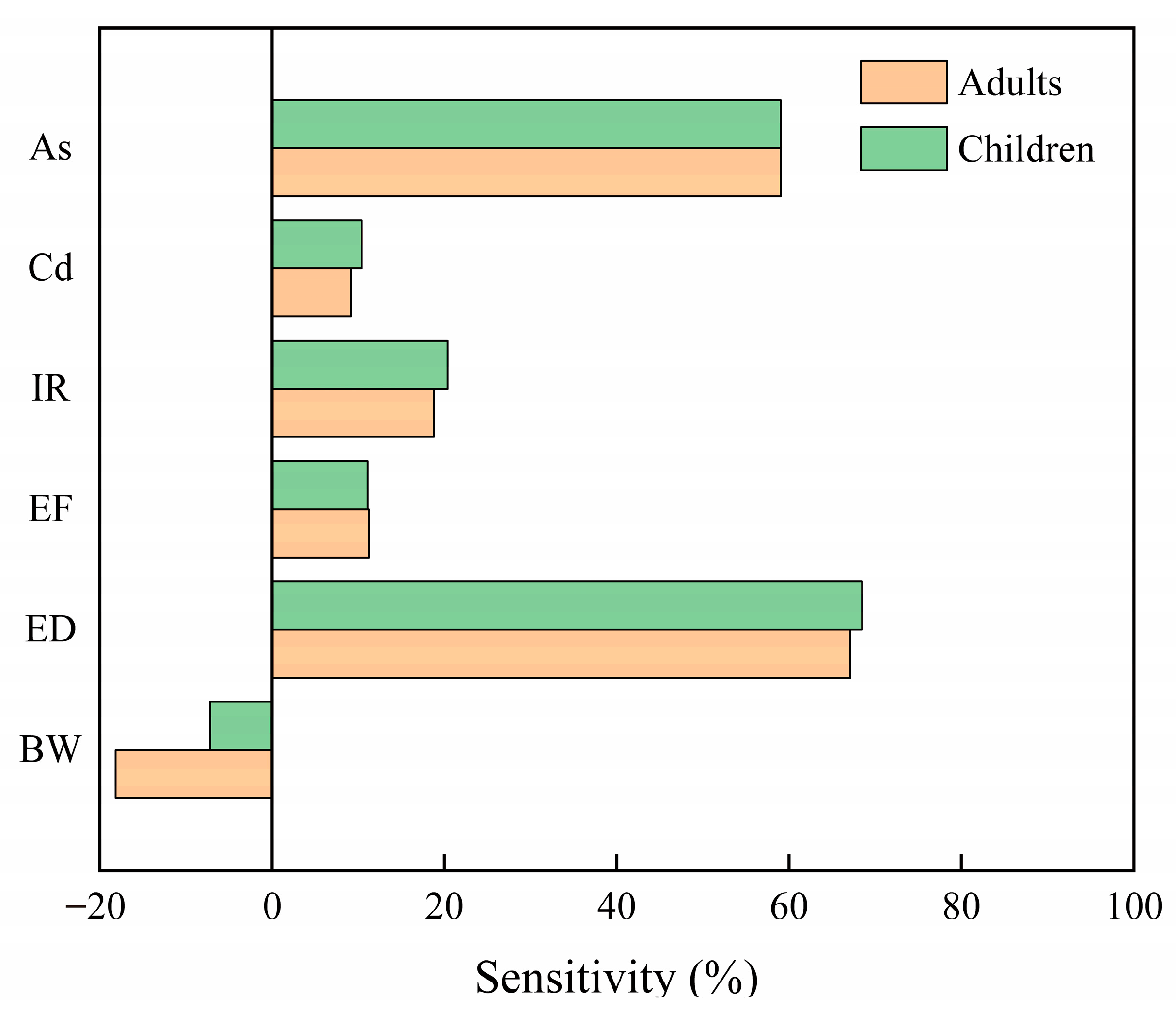
| Indicator | Test Method | Detection Limit | Indicator | Test Method | Detection Limit |
|---|---|---|---|---|---|
| Ca2+ | Inductively Coupled Plasma Optical Emission Spectrometer (ICP-OES) | 0.004 | Al | Inductively Coupled Plasma Mass Spectrometry (ICP-MS) | 0.009 |
| Mg2+ | 0.01 | Ni | 0.007 | ||
| Na+ | 0.01 | Zn | 0.001 | ||
| K+ | 0.01 | Cu | 0.006 | ||
| HCO3− | 5 | Cd | 0.002 | ||
| Mn | 0.01 | Pb | 0.05 | ||
| Hg | Atomic Fluorescence Spectroscopy (AFS) | 0.0001 | TH | 10 | |
| As | 0.001 | SO42− | Ion Chromatograph (ICS) | 0.2 | |
| Se | 0.03 | Cl− | 0.1 | ||
| NO2−-N | Ultraviolet-Visible Spectroscopy (UV-Vis) | 0.005 | NO3−-N | 0.02 | |
| NH4+-N | 0.007 | F− | 0.006 | ||
| I | 0.025 | TDS | 4 | ||
| pH | Glass Electrode (GE) | 0.1 |
| EWQI | Grades | Classifications |
|---|---|---|
| EWQI ≤ 50 | I | Excellent |
| 50 < EWQI ≤ I100 | II | Good |
| 100 < EWQI ≤ 150 | III | Medium |
| 150 < EWQI ≤ 200 | IV | Poor |
| EWQI > 200 | V | Extremely poor |
| Index | RfD | Index | RfD | Index | RfD | Index | RfD | Index | SF |
|---|---|---|---|---|---|---|---|---|---|
| As | 0.0003 | I | 0.01 | Zn | 0.3 | Se | 0.005 | As | 1.5 |
| Cd | 0.0005 | F− | 0.04 | Ni | 0.02 | SO42− | 120 | Cd | 6.1 |
| Al | 0.14 | NO3− | 1.6 | Mn | 0.14 | Pb | 0.0014 | ||
| Cu | 0.04 | NO2− | 0.1 | Hg | 0.0003 | NH4+ | 0.97 |
| Parameters | Meaning | Regularities of Distribution | Reference Values | Units | |
|---|---|---|---|---|---|
| Adults | Children | ||||
| IR | Daily ingestion rate | Logarithmic normal distribution | (1.23,0.27) | (1.12,0.27) | L∙d−1 |
| EF | Exposure duration | Triangular distribution | (180,350,365) | (180,350,365) | d∙a−1 |
| BW | The average weight | Normal distribution | (56.4,11.9) | (16.68,1.48) | kg |
| ED | Exposure duration | Uniform distribution | (0,70) | (0,10) | a |
| AT | Average exposure time | Point | 10950 | 2190 | d |
| Cw | Concentration of each component | Determined through fitting | Measured | Measured | mg∙L−1 |
| Min | Max | AV | SD | CV | SK | KU | STD | SEL | |
|---|---|---|---|---|---|---|---|---|---|
| pH | 6.13 | 9.07 | 7.368 | 0.382 | 5.18% | 0.337 | 3.226 | 6.50–8.50 | 4 |
| Ca2+ | 3.13 | 208 | 42.548 | 33.265 | 78.18% | 1.474 | 3.588 | 200 | 1 |
| Mg2+ | 0.517 | 73.8 | 5.926 | 6.632 | 111.91% | 6.994 | 68.335 | 150 | 0 |
| Na+ | 0.658 | 51 | 10.011 | 8.729 | 87.19% | 2.29 | 6.695 | 200 | 0 |
| K+ | 0.07 | 22.3 | 4.425 | 5.020 | 113.44% | 1.768 | 2.723 | - | - |
| HCO3− | 9.52 | 558 | 138.790 | 98.137 | 70.71% | 1.141 | 1.36 | - | - |
| SO42− | 0.343 | 544 | 22.961 | 46.706 | 203.41% | 9.003 | 97.473 | 250 | 1 |
| Cl− | 0.007 | 58.6 | 10.867 | 10.714 | 98.59% | 1.598 | 2.663 | 250 | 0 |
| NO3−-N | 0.062 | 16.303 | 2.811 | 2.870 | 102.09% | 1.914 | 4.424 | 20 | 0 |
| NO2−-N | 0.005 | 0.667 | 0.039 | 0.097 | 247.85% | 4.075 | 24.630 | 1.0 | 0 |
| NH4+-N | 0.007 | 3.71 | 0.084 | 0.307 | 367.41% | 10.675 | 123.259 | 0.5 | 2 |
| I | 0.025 | 1.9 | 0.074 | 0.204 | 276.51% | 7.986 | 66.216 | 0.008 | 22 |
| Mn | 0.01 | 3.75 | 0.120 | 0.454 | 376.87% | 6.516 | 45.348 | 0.1 | 23 |
| Al | 0.009 | 0.651 | 0.064 | 0.095 | 148.05% | 3.312 | 13.117 | 0.2 | 11 |
| Ni | 0.00006 | 0.229 | 0.0058 | 0.0188 | 322.15% | 10.647 | 125.514 | 0.02 | 6 |
| Zn | 0.00067 | 1.455 | 0.047 | 0.117 | 245.75% | 11.065 | 133.49 | 1.0 | 1 |
| Cu | 0.00008 | 0.032 | 0.0016 | 0.0035 | 217.81% | 6.173 | 46.06 | 1.0 | 0 |
| Cd | 0.00005 | 0.00067 | 0.0001 | 0.0001 | 106.99% | 4.975 | 27.562 | 0.005 | 0 |
| Pb | 0.00009 | 0.00712 | 0.0029 | 0.0019 | 65.09% | −0.151 | −1.192 | 0.01 | 0 |
| Hg | 0.00004 | 0.00879 | 0.0001 | 0.0007 | 678.97% | 12.582 | 159.376 | 0.001 | 1 |
| As | 0.0003 | 0.0204 | 0.0015 | 0.0024 | 158.12% | 4.341 | 24.951 | 0.01 | 3 |
| Se | 0.0004 | 0.0129 | 0.0006 | 0.0010 | 178.19% | 11.804 | 145.838 | 0.01 | 1 |
| F− | 0.006 | 2.12 | 0.142 | 0.177 | 124.56% | 8.891 | 96.996 | 1.00 | 1 |
| TDS | 8 | 528 | 157.343 | 99.079 | 62.97% | 0.888 | 0.523 | 1000 | 0 |
| TH | 8.01 | 524 | 119.437 | 85.227 | 71.36% | 1.239 | 2.398 | 450 | 1 |
| Correlation | ||||||||||||||||||||||||||
|---|---|---|---|---|---|---|---|---|---|---|---|---|---|---|---|---|---|---|---|---|---|---|---|---|---|---|
| EWQI | pH | Ca2+ | Mg2+ | Na+ | K+ | HCO3− | SO42− | Cl− | NO3−-N | NO2−-N | NH4+-N | I | Mn | Al | Ni | Zn | Cu | Cd | Pb | Hg | As | Se | F− | TDS | TH | |
| EWQI | 1 | |||||||||||||||||||||||||
| pH | −0.046 | 1 | ||||||||||||||||||||||||
| Ca2+ | 0.193 | 0.303 ** | 1 | |||||||||||||||||||||||
| Mg2+ | 0.250 * | 0.171 | 0.551 ** | 1 | ||||||||||||||||||||||
| Na+ | 0.277 * | 0.342 ** | 0.243 * | 0.381 ** | 1 | |||||||||||||||||||||
| K+ | −0.067 | 0.068 | −0.011 | −0.043 | −0.139 | 1 | ||||||||||||||||||||
| HCO3− | 0.292 * | 0.335 ** | 0.911 ** | 0.609 ** | 0.383 ** | −0.082 | 1 | |||||||||||||||||||
| SO42− | 0.136 | 0.145 | 0.531 ** | 0.462 ** | 0.185 | 0.2 | 0.346 ** | 1 | ||||||||||||||||||
| Cl− | 0.272 * | 0.19 | 0.281 * | 0.495 ** | 0.545 ** | 0.08 | 0.294 ** | 0.255 * | 1 | |||||||||||||||||
| NO3−-N | −0.056 | −0.045 | −0.021 | 0.058 | 0.12 | −0.047 | −0.176 | 0.032 | 0.313 ** | 1 | ||||||||||||||||
| NO2−-N | 0.262 * | −0.051 | 0.256 * | 0.138 | 0.307 ** | −0.161 | 0.193 | 0.131 | 0.343 ** | 0.196 | 1 | |||||||||||||||
| NH4+-N | 0.042 | 0.356 ** | −0.103 | −0.078 | 0.393 ** | −0.118 | −0.013 | 0.019 | −0.038 | −0.093 | 0.057 | 1 | ||||||||||||||
| I | 0.307 ** | 0.047 | 0.13 | 0.046 | 0.341 ** | 0.001 | 0.103 | 0.165 | 0.373 ** | 0.197 | 0.103 | −0.022 | 1 | |||||||||||||
| Mn | 0.972 ** | −0.083 | 0.148 | 0.229 * | 0.179 | −0.065 | 0.264 * | 0.074 | 0.174 | −0.132 | 0.226 * | 0.016 | 0.081 | 1 | ||||||||||||
| Al | 0.609 ** | −0.003 | −0.019 | 0.101 | 0.111 | −0.129 | 0.027 | −0.044 | 0.169 | −0.045 | 0.267 * | −0.025 | 0.014 | 0.627 ** | 1 | |||||||||||
| Ni | 0.036 | 0.331 ** | 0.121 | 0.17 | 0.063 | 0.112 | 0.082 | 0.400 ** | −0.01 | −0.132 | −0.12 | 0.103 | 0.032 | 0.014 | 0.027 | 1 | ||||||||||
| Zn | −0.039 | 0.204 | 0.033 | −0.029 | 0.206 | −0.138 | −0.005 | 0.133 | −0.007 | 0.006 | 0.201 | 0.468 ** | −0.072 | −0.052 | 0.112 | 0.204 | 1 | |||||||||
| Cu | 0.069 | 0.102 | 0.097 | −0.07 | 0.342 ** | −0.14 | 0.051 | −0.002 | 0.134 | 0.316 ** | 0.177 | 0.017 | 0.356 ** | −0.027 | 0.172 | 0.036 | 0.064 | 1 | ||||||||
| Cd | 0.005 | 0.073 | 0.230 * | 0 | −0.098 | −0.056 | 0.127 | 0.131 | −0.092 | −0.082 | −0.032 | −0.045 | 0.136 | −0.029 | 0.027 | 0.321 ** | 0.195 | 0.11 | 1 | |||||||
| Pb | −0.007 | 0.260 * | −0.089 | −0.002 | 0.1 | 0.149 | −0.042 | −0.01 | 0.157 | 0.069 | −0.412 ** | −0.097 | 0.186 | −0.046 | −0.07 | 0.287 * | −0.241 * | 0.117 | 0.121 | 1 | ||||||
| Hg | 0.019 | −0.005 | 0.226 * | 0.152 | 0.131 | −0.101 | 0.228 * | 0.032 | 0.132 | −0.104 | 0.516 ** | 0.075 | −0.032 | 0.021 | −0.06 | −0.054 | −0.054 | 0.017 | −0.032 | −0.205 | 1 | |||||
| As | 0.240 * | 0.117 | 0.194 | 0.058 | 0.196 | −0.027 | 0.262 * | 0.076 | −0.03 | 0.116 | −0.044 | −0.046 | 0.017 | 0.246 * | −0.059 | −0.056 | −0.168 | 0.12 | −0.09 | 0.228 * | −0.087 | 1 | ||||
| Se | −0.076 | 0.014 | 0.21 | 0.056 | 0.013 | −0.128 | 0.113 | 0.058 | 0.109 | 0.191 | 0.132 | −0.067 | −0.04 | −0.079 | −0.073 | −0.066 | 0.143 | 0.074 | 0.262 * | −0.059 | −0.017 | 0.04 | 1 | |||
| F− | −0.056 | 0.034 | −0.042 | 0.004 | 0.027 | 0.228 * | −0.006 | 0.168 | 0.034 | −0.212 | −0.116 | 0.02 | −0.021 | −0.054 | −0.007 | 0.193 | −0.037 | −0.171 | 0.01 | 0.178 | −0.113 | −0.063 | −0.018 | 1 | ||
| TDS | 0.156 | 0.237 * | 0.663 ** | 0.479 ** | 0.408 ** | −0.139 | 0.626 ** | 0.383 ** | 0.295 ** | 0.117 | 0.383 ** | 0.1 | 0.163 | 0.095 | −0.009 | 0.043 | 0.293 * | 0.188 | 0.112 | −0.268 * | 0.216 | 0.154 | 0.144 | −0.275 * | 1 | 0.622 ** |
| TH | 0.11 | 0.280 * | 0.874 ** | 0.638 ** | 0.293 * | 0.021 | 0.822 ** | 0.615 ** | 0.333 ** | 0.083 | 0.196 | −0.074 | 0.131 | 0.057 | −0.144 | 0.17 | −0.041 | 0.084 | −0.048 | −0.084 | 0.172 | 0.247 * | 0.107 | −0.003 | 0.622 ** | 1 |
| Indicators | Principal Component | |||
|---|---|---|---|---|
| 1 | 2 | 3 | 4 | |
| Ca2+ | 0.929 | 0.061 | −0.018 | 0.013 |
| Mg2+ | 0.750 | 0.250 | 0.159 | 0.021 |
| Na+ | 0.284 | 0.742 | 0.091 | −0.227 |
| K+ | −0.047 | −0.017 | −0.056 | 0.920 |
| HCO3− | 0.908 | 0.108 | 0.076 | −0.147 |
| SO42− | 0.610 | 0.155 | −0.038 | 0.468 |
| Cl− | 0.278 | 0.760 | 0.167 | 0.138 |
| I | −0.041 | 0.773 | −0.048 | 0.068 |
| Mn | 0.174 | 0.066 | 0.878 | −0.011 |
| Al | −0.052 | 0.059 | 0.906 | −0.067 |
| Feature Value | 2.817 | 1.836 | 1.666 | 1.167 |
| Accumulation(%) | 28.166 | 18.357 | 16.66 | 11.672 |
| Index | NH4+-N | SO42− | F− | NO2−-N | NO3−-N | Al | Mn | Ni | I |
| Adults | 1.39 × 10−3 | 0.49 | 2.97 × 10−3 | 7.26 × 10−4 | 6.14 × 10−2 | 1.28 × 10−3 | 1.68 × 10−3 | 2.21 × 10−4 | 1.52 × 10−3 |
| Children | 2.94 × 10−3 | 1.01 | 6.30 × 10−3 | 1.64 × 10−3 | 1.28 × 10−1 | 2.78 × 10−3 | 3.80 × 10−3 | 4.40 × 10−4 | 3.28 × 10−3 |
| Index | Zn | Cu | Cd | Pb | Hg | As | Se | ADD | |
| Adults | 9.68 × 10−4 | 3.50 × 10−5 | 1.64 × 10−6 | 6.32 × 10−5 | 1.06 × 10−6 | 2.97 × 10−5 | 1.09 × 10−5 | 0.56 | |
| Children | 1.99 × 10−3 | 7.34 × 10−5 | 3.48 × 10−6 | 1.33 × 10−4 | 2.32 × 10−6 | 6.26 × 10−5 | 2.31 × 10−5 | 1.16 |
| Index | NH4+-N | SO42− | F− | |||
| statistic | Mean | 95% Confidence Interval | Mean | 95% Confidence Interval | Mean | 95% Confidence Interval |
| Adults | 1.44 × 10−3 | (3.71 × 10−5, 5.31 × 10−3) | 4.09 × 10−3 | (1.20 × 10−4, 1.49 × 10−2) | 7.43 × 10−2 | (4.52 × 10−3, 2.27 × 10−1) |
| Children | 3.03 × 10−3 | (7.59 × 10−5, 1.14 × 10−2) | 8.40 × 10−3 | (2.55 × 10−4, 3.04 × 10−2) | 1.57 × 10−1 | (9.23 × 10−3, 4.82 × 10−1) |
| Index | I | NO2−-N | NO3−-N | |||
| statistic | Mean | 95% Confidence Interval | Mean | 95% Confidence Interval | Mean | 95% Confidence Interval |
| Adults | 1.52 × 10−1 | (7.26 × 10−3, 4.53 × 10−1) | 7.26 × 10−3 | (1.51 × 10−4, 2.25 × 10−2) | 3.84 × 10−2 | (7.09 × 10−4, 1.42 × 10−1) |
| Children | 3.28 × 10−1 | (1.43 × 10−2, 9.85 × 10−1) | 1.64 × 10−2 | (3.16 × 10−4, 4.97 × 10−2) | 7.98 × 10−2 | (1.43 × 10−3, 2.94 × 10−1) |
| Index | Al | Mn | Ni | |||
| statistic | Mean | 95% Confidence Interval | Mean | 95% Confidence Interval | Mean | 95% Confidence Interval |
| Adults | 9.15 × 10−3 | (2.58 × 10−4, 3.41 × 10−2) | 1.20 × 10−2 | (2.24 × 10−4, 3.73 × 10−2) | 1.11 × 10−2 | (2.67 × 10−5, 3.72 × 10−2) |
| Children | 1.99 × 10−2 | (5.02 × 10−4, 7.35 × 10−2) | 2.71 × 10−2 | (4.54 × 10−4, 8.28 × 10−2) | 2.20 × 10−2 | (6.01 × 10−5, 8.23 × 10−2) |
| Index | Zn | Cu | Cd | |||
| statistic | Mean | 95% Confidence Interval | Mean | 95% Confidence Interval | Mean | 95% Confidence Interval |
| Adults | 3.23 × 10−3 | (1.07 × 10−4, 1.21 × 10−2) | 8.75 × 10−4 | (1.12 × 10−5, 3.49 × 10−3) | 3.28 × 10−3 | (2.39 × 10−4, 9.21 × 10−2) |
| Children | 6.63 × 10−3 | (2.31 × 10−4,2.45 × 10−2) | 1.83 × 10−3 | (2.29 × 10−5, 7.51 × 10−3) | 6.93 × 10−3 | (4.71 × 10−4, 1.95 × 10−2) |
| Index | Pb | Hg | As | |||
| statistic | Mean | 95% Confidence Interval | Mean | 95% Confidence Interval | Mean | 95% Confidence Interval |
| Adults | 4.51 × 10−2 | (1.49 × 10−3, 1.40 × 10−1) | 3.54 × 10−3 | (2.67 × 10−4, 7.47 × 10−3) | 9.90 × 10−2 | (3.46 × 10−3, 3.55 × 10−1) |
| Children | 9.48 × 10−2 | (3.21 × 10−3, 2.91 × 10−1) | 7.72 × 10−3 | (5.64 × 10−4, 1.48 × 10−2) | 2.09 × 10−1 | (7.52 × 10−3, 7.15 × 10−1) |
| Index | Se | HQ | ||||
| statistic | Mean | 95% Confidence Interval | Mean | 95% Confidence Interval | ||
| Adults | 2.19 × 10−3 | (1.69 × 10−4, 5.79 × 10−3) | 0.467 | (0.032, 1.25) | ||
| Children | 4.61 × 10−3 | (3.52 × 10−4, 1.20 × 10−2) | 0.993 | (0.066, 2.58) | ||
| Index | As | Cd | CR | |||
|---|---|---|---|---|---|---|
| statistic | Mean | 95% Confidence Interval | Mean | 95% Confidence Interval | Mean | 95% Confidence Interval |
| Adults | 4.46 × 10−5 | (1.56 × 10−6, 1.60 × 10−4) | 1.00 × 10−5 | (7.28 × 10−7, 2.81 × 10−5) | 5.46 × 10−5 | (2.79 × 10−6, 1.80 × 10−4) |
| Children | 9.38 × 10−5 | (3.39 × 10−6, 3.22 × 10−4) | 2.12 × 10−5 | (1.44 × 10−6, 5.94 × 10−5) | 1.15 × 10−4 | (5.92 × 10−6, 3.68 × 10−4) |
Disclaimer/Publisher’s Note: The statements, opinions and data contained in all publications are solely those of the individual author(s) and contributor(s) and not of MDPI and/or the editor(s). MDPI and/or the editor(s) disclaim responsibility for any injury to people or property resulting from any ideas, methods, instructions or products referred to in the content. |
© 2025 by the authors. Licensee MDPI, Basel, Switzerland. This article is an open access article distributed under the terms and conditions of the Creative Commons Attribution (CC BY) license (https://creativecommons.org/licenses/by/4.0/).
Share and Cite
Zhao, L.; Geng, B.; Zhao, M.; Li, B.; Miao, Q.; Liu, S.; Zhao, Z.; Wang, H.; Li, Y.; Jin, W.; et al. Evaluation of Groundwater Quality and Health Risk Assessment During the Dry Season in the Xin’an River Basin, China. Water 2025, 17, 2412. https://doi.org/10.3390/w17162412
Zhao L, Geng B, Zhao M, Li B, Miao Q, Liu S, Zhao Z, Wang H, Li Y, Jin W, et al. Evaluation of Groundwater Quality and Health Risk Assessment During the Dry Season in the Xin’an River Basin, China. Water. 2025; 17(16):2412. https://doi.org/10.3390/w17162412
Chicago/Turabian StyleZhao, Liyuan, Baili Geng, Mingjie Zhao, Baofei Li, Qingzhuang Miao, Shigao Liu, Zhigang Zhao, Haiyu Wang, Yuyan Li, Wei Jin, and et al. 2025. "Evaluation of Groundwater Quality and Health Risk Assessment During the Dry Season in the Xin’an River Basin, China" Water 17, no. 16: 2412. https://doi.org/10.3390/w17162412
APA StyleZhao, L., Geng, B., Zhao, M., Li, B., Miao, Q., Liu, S., Zhao, Z., Wang, H., Li, Y., Jin, W., Zhang, X., Sun, Y., Wu, H., & Wang, J. (2025). Evaluation of Groundwater Quality and Health Risk Assessment During the Dry Season in the Xin’an River Basin, China. Water, 17(16), 2412. https://doi.org/10.3390/w17162412






